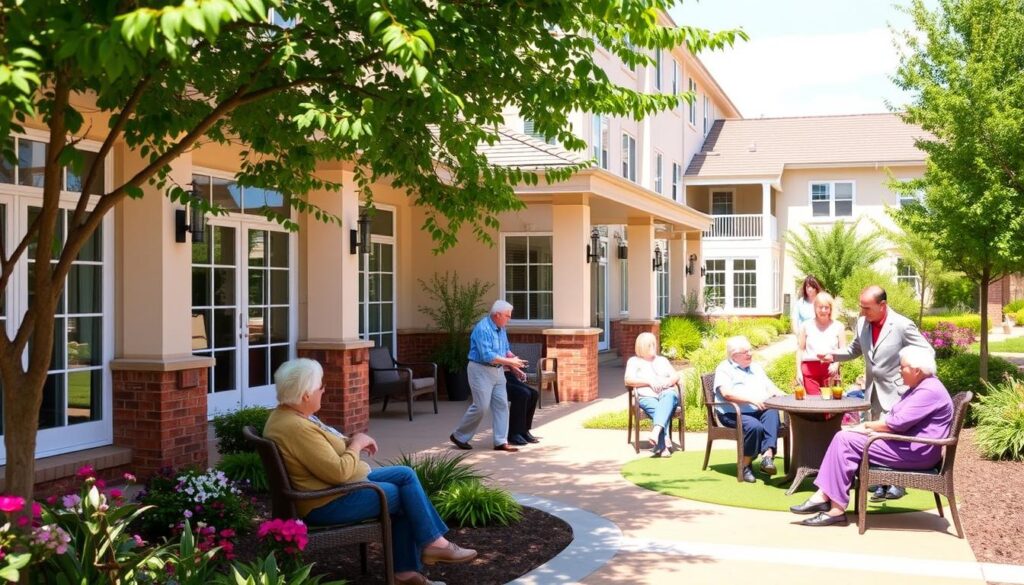Long-term health care helps people who need ongoing medical care and daily help. It offers many services and support systems. These help people stay independent and live well as they age or face chronic illnesses. This guide covers long-term care options, planning, and important things to think about for individuals and families.
Key Takeaways
- Long-term health care offers many services and support systems to help people stay independent and live well as they age or manage chronic conditions.
- Planning for long-term care means understanding the different care options, financial considerations, and support programs available.
- Medicaid and Medicare help cover some long-term care costs, but people may also need to look into long-term care insurance and other financial planning strategies.
- Quality of life and wellness programs are key to improving the well-being of those receiving long-term care.
- Choosing the right long-term care provider is crucial for getting the best care and support.
Understanding Long-term Health Care Fundamentals
Long-term care helps people with daily tasks and medical needs. It includes personal care, home care, and therapy. It’s important to plan for it early, ideally in your 50s or 60s.
Key Components of Long-term Care
When planning for long-term care, consider your health, finances, and living situation. This helps figure out the care you might need later. Medical checks are key to making a care plan that fits your needs.
When to Start Planning for Long-term Care
Experts say to start planning in your 50s or 60s. The costs and options change a lot. For example, a private room in a nursing home costs about $108,405 a year.
Home health aides cost around $61,776 yearly. Buying long-term care insurance early can save money. A couple, both 55, paid $2,080 in 2021.
The Role of Medical Assessment
A detailed medical check is vital to find the right care. It looks at physical, cognitive, and functional abilities. This helps create a care plan that meets your needs and preferences.
Understanding long-term care helps make smart choices for your future. It ensures you get the support and services you need to live well.
Types of Long-term Care Services and Facilities
Long-term care services are available in many settings. Each setting offers different levels of support and medical care. These options range from care at home to specialized facilities, meeting the needs of those needing extended help.
Home-Based Care
Home-based care lets people get help while staying at home. Home Health Aides can help with personal care like bathing and dressing. They also manage medications and do light household tasks. Rehabilitation Services like physical therapy can also be done at home. This helps keep people independent and improves their quality of life.
Adult Daycare Centers
Adult daycare centers are places where older adults can socialize and get Palliative Care. They also offer some health services during the day. These centers give caregivers a break and let participants meet others.
Residential Facilities
There are two main types of residential care: assisted living and nursing homes. Assisted living offers a more independent living space with daily support. Nursing homes provide 24/7 medical care and supervision for those with serious health issues.
| Facility Type | Description | Common Services |
|---|---|---|
| Assisted Living | Residential setting with support for daily activities | Personal care, meals, social activities, medication management |
| Nursing Homes | 24-hour medical care and supervision for those with complex health needs | Skilled nursing, rehabilitation, Palliative Care, end-of-life care |
Knowing about the different long-term care services and facilities helps people make better choices. They can find the best fit for their needs and preferences.

Home-Based Care Options and Support Systems
For elderly or those with chronic illnesses, staying at home is key. They want to keep their independence and quality of life. Luckily, many home care options and support systems are available to help.
Personal Care Services
Personal care services help with daily tasks like bathing and dressing. They ensure the elderly and those with chronic illnesses stay clean and dignified at home. Programs like Community First Choice and Personal Assistance Services help thousands get this care.
Home Health Aide Services
Home health aides work with doctors to provide medical care at home. They help with things like taking medicine and checking vital signs. Medicare covers up to 8 hours a day of this care, for up to 28 hours a week.
Household Assistance Programs
There’s also help with household tasks. Household Assistance Programs aid with cooking, cleaning, and more. This lets the elderly and those with chronic illnesses stay independent and focus on their health.
These home care options and support systems help with Elderly Care, Chronic Illness Management, and Caregiver Support. They let people live well in their own homes.
| Service | Description | Key Benefits |
|---|---|---|
| Personal Care Services | Assistance with activities of daily living, such as bathing, dressing, and grooming. | Maintain personal hygiene and dignity while remaining in the home. |
| Home Health Aide Services | Medical care and support provided under the supervision of healthcare professionals. | Medication management, wound care, and monitoring of vital signs. |
| Household Assistance Programs | Help with everyday tasks like meal preparation, light housekeeping, and transportation. | Maintain independence and focus on well-being. |
“The scheduling of appointments and implementation of care plans should not lead to delays in accessing home health services.”
Assisted Living and Nursing Home Facilities
For those needing more care, assisted living and nursing homes offer specialized services. These places help seniors move between levels of care as their health changes. This way, they can stay independent while getting the support they need.
Assisted Living Facilities
Assisted living facilities (ALFs) offer a home-like setting with help for daily tasks and social programs. They help residents stay independent while getting the support they need. ALFs have trained staff to look after residents and help with their health care.
Nursing Homes
Nursing homes provide 24-hour care and medical attention for those needing more help. They have skilled staff like nurses and doctors to watch over residents all day. These homes are for those with serious health needs, making sure they get the care they need.
Choosing between assisted living and nursing homes depends on the person’s needs and what they want. It’s important to think about their health, social needs, and the facility’s environment. This way, families can choose the best place for their loved one’s safety, comfort, and happiness.
| Assisted Living Facilities | Nursing Homes |
|---|---|
| Residential setting with personalized assistance for daily activities, medication management, and social programs | 24-hour skilled nursing care and comprehensive medical attention for those with complex needs |
| Balanced approach, enabling independence with necessary support | Staffed by trained healthcare professionals, including nurses, therapists, and physicians |
| Trained staff to oversee residents’ well-being and coordinate healthcare services | Provide around-the-clock monitoring, rehabilitation services, and specialized therapies |
The right choice between assisted living and nursing homes depends on the person’s needs and what they prefer. It’s about finding the right support for their health and happiness in the long run.

Financial Planning for Long-term Health Care
Planning for long-term health care costs is key. Knowing about Medicare/Medicaid and long-term care insurance helps. This knowledge aids in making smart choices for care needs.
Medicare and Medicaid Coverage
Medicare usually covers short-term care. Medicaid might help with long-term care for those who qualify financially. But, Medicaid rules vary by state.
Long-term Care Insurance Options
Long-term care insurance can fill gaps not covered by government programs. Premiums depend on age, health, and coverage level. Getting advice from financial experts is wise.
Veterans’ Benefits and Support
Veterans and spouses might get extra help through Aid and Attendance. This can cover costs for care at home, in assisted living, or nursing homes.
Good long-term care planning means knowing all financial options. By exploring and getting advice, people can prepare well for their care needs.
| Long-term Care Cost | Average Annual Cost |
|---|---|
| Assisted Living | $54,000 |
| Home Health Aide | $61,776 |
| Nursing Home (Private Room) | $108,405 |
“Effective long-term care planning involves good communication with family members to ensure care aligns with the individual’s wishes and needs.”
Quality of Life and Wellness Programs
In long-term care, quality of life and wellness programs are key. They help keep people physically, mentally, and socially well. These programs help people take charge of their health and live more fulfilling lives.
At the core are rehabilitation services. They aim to help people with chronic conditions or disabilities. Physical therapy, occupational therapy, and fun activities improve mobility and fitness.
Palliative care focuses on comfort and quality of life for those with serious illnesses. It ensures their needs are met with care and respect.
Nutrition is also crucial. Personalized meal plans meet each person’s dietary needs. This boosts health, energy, and helps manage chronic illnesses like diabetes and obesity.
These programs also care for mental and social well-being. Activities like group fitness and creative workshops keep people connected. This approach to care ensures medical support and a chance to thrive.
By combining Chronic Illness Management, Rehabilitation Services, and Palliative Care, long-term care providers empower people. They help maintain independence, manage conditions, and find joy in life. This holistic approach is vital for a better quality of life.
| Service | Description |
|---|---|
| Physical Therapy | Improves mobility, strength, and balance. It helps people stay independent and do daily activities easily. |
| Occupational Therapy | Enhances ability to do self-care, work, and leisure activities. It promotes function and quality of life. |
| Recreational Activities | Offers social engagement, cognitive stimulation, and physical exercise. It boosts well-being and enjoyment. |
| Nutrition Programs | Provides personalized meal plans and dietary guidance. It supports chronic condition management and overall health. |
| Palliative Care | Provides comfort, pain relief, and emotional support for serious illnesses. It enhances quality of life. |
By integrating these essential services into wellness programs, long-term care providers empower individuals. They help maintain independence, manage conditions, and find joy in daily life.
Choosing the Right Long-term Care Provider
Finding the right long-term care provider is a big decision. Start by using tools like Medicare’s Nursing Home Compare. This helps you see the quality of care, staff ratios, services, and the place’s atmosphere.
It’s key to visit facilities in person. Look at how staff and residents interact. Also, check the cleanliness and feel of the place. Talk to healthcare experts, social workers, and long-term care ombudsmen for advice.
Look at the provider’s experience and reputation. Make sure they can meet your care needs now or in the future. Also, check the costs and what insurance might cover. This way, you can choose a provider that fits your needs and budget.















Leave a Reply